Almost 10 billion tons of freight is transported by trucks yearly in the United States, which amounts to more than $700 billion in annual revenue. The trucking industry has been growing steadily over the past decade as global trade is on the rise and e-commerce has become more popular.
Load boards are online freight matching services that connect shippers and brokers with trucking companies and owner-operators. They allow shippers and brokers to post their available loads onto the platform and carriers bid to move these loads with their trucks.
A load board essentially matches available loads of a shipper or broker to suitable trucks of carriers (trucking companies and owner-operators). This allows trucking companies to take advantage of the high demand for trucking services and maximize profitability.
In this article, we’ll be taking a detailed look at how load boards work, what their advantages and disadvantages are, how much they cost, how to use them, and how to select the best load board to suit your needs.
How Load Boards Work
As load boards have a similar concept to online marketplaces where freight is sourced and procured, there are sellers and buyers. In this regard, the party that is selling their freight space (the ability to move cargo between two or more locations) are carriers, which are trucking companies and independent trucking operators (also known as owner-operators)
On the other hand, there are parties that require freight movements, which are shippers and freight brokers. Shippers require cargo to be moved from one place to another, whereby brokers connect shippers with various types of subcontractors (in this case trucking companies).
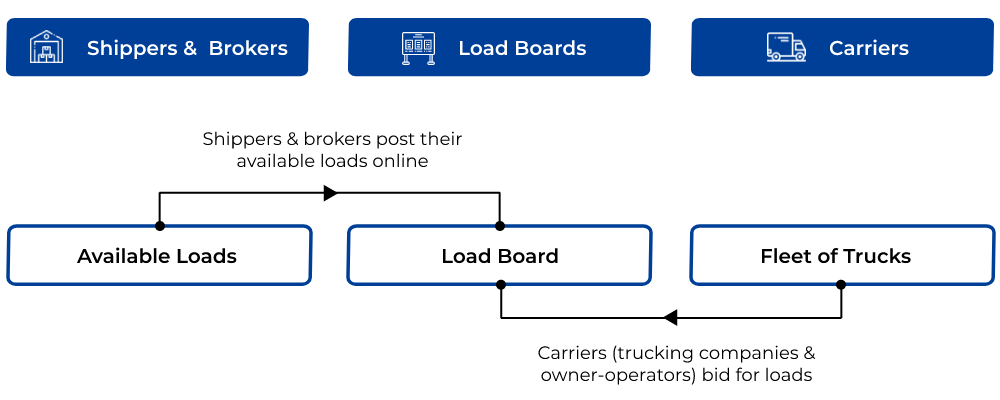
Due to the dynamics of freight buyers and sellers, each party uses load boards differently, depending on their purpose. Let’s explore this in more detail.
How Shippers & Brokers Use Load Boards
When using load boards, shippers and brokers have the ability to post their available loads, look for suitable trucks, and use additional tools on their preferred platform to observe market rates and establish prices.
Essentially, load boards help shippers and brokers find trucks that fit their cargo requirements effectively and efficiently. They can also post loads and related details on the platform to negotiate better rates with interested truckers.
Most load boards have an in-built rate tool that allows them to view specific routes and average market prices so they can establish reasonable rates with carriers. Here’s some of the information that carriers and brokers need to provide when listing a load:
- Cargo Details (weight, dimensions & quantity)
- Pickup Details (pickup address, date & time)
- Delivery Details (delivery address, date & time)
- Additional Instructions
- Freight Rate
How Carriers Use Load Boards
On the other hand, carriers (trucking companies and owner-operators) have the ability to browse through available loads that are posted by shippers and brokers, post available truck capacities, and monitor market rates to negotiate prices.
Load boards are a fantastic and convenient way to access available loads without having to source opportunities using traditional methods. Carriers can search freight options that fit their requirements using a variety of filters that include, maximum weight, pickup location, trailer type, and more.
Once a carrier has found a load that they’re interested in moving, they simply apply a bid for it on the load board and the shipper can now validate and approve. Upon approval from the shipper or broker, the freight is officially matched.
Should You Be Using a Load Board?
Load boards are a great way to connect freight brokers, shippers, and carriers. There are many benefits to using a freight matching platform to increase profitability and trucking utilization. However, there may be some drawbacks that could be overlooked.
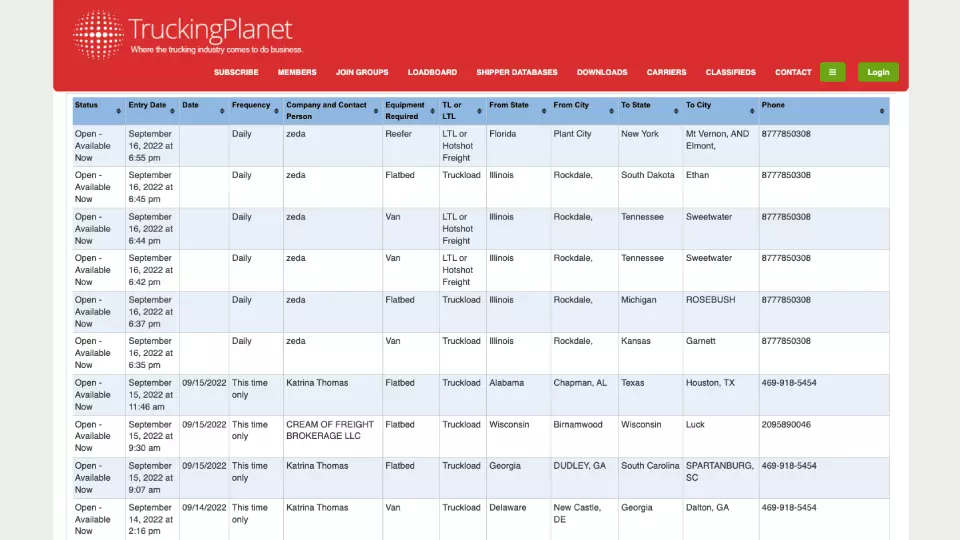
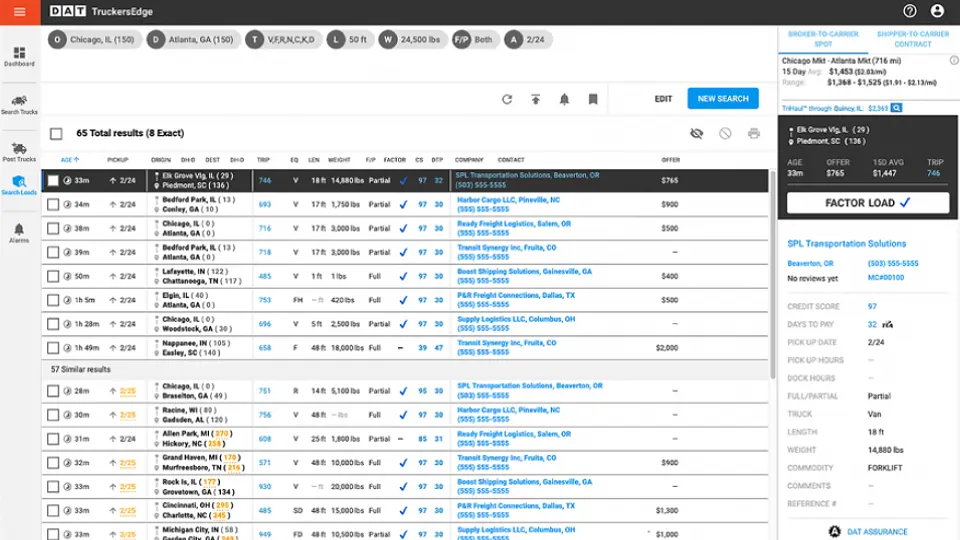
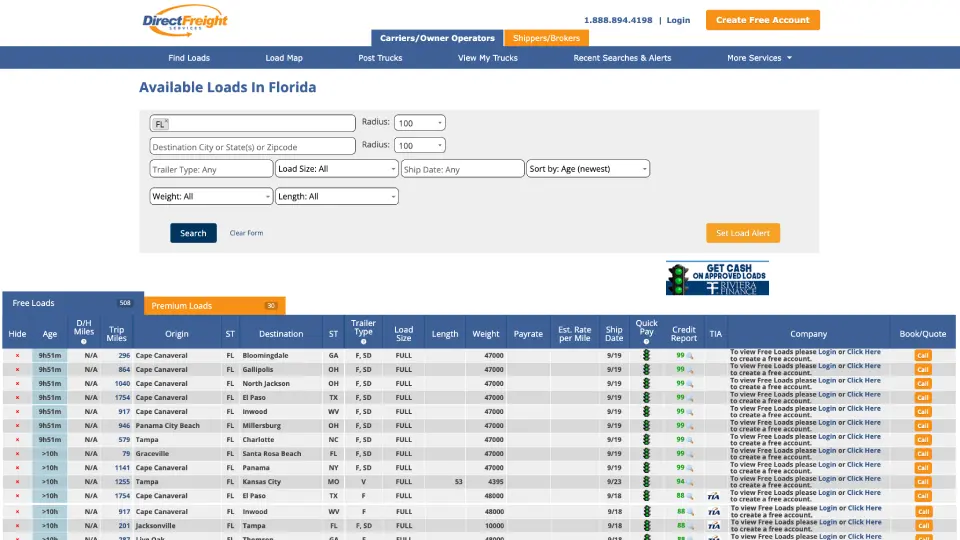
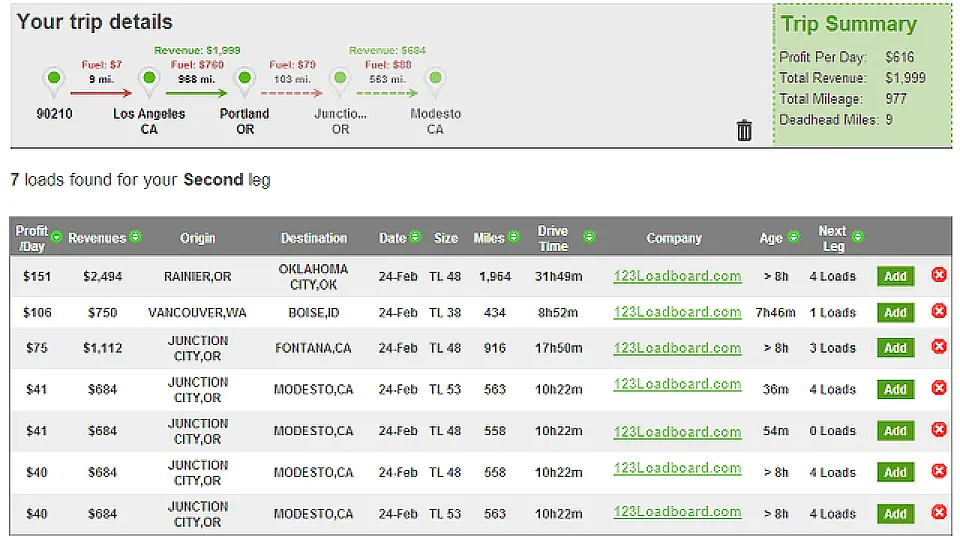
In this section, we will look at various advantages and disadvantages of using load boards, both from a carrier’s and shipper’s perspective.
Advantages
- Convenience – Load boards allow carriers to bid for freight efficiently and effectively, through a single online platform. They can receive information and notifications according to their preferences and shippers can easily post their available loads.
- Extensive Network – Load boards contain a large database of shippers, brokers, and trucking companies. This also means that all parties are able to source for and list loads beyond their locale and tap into opportunities in other cities and states.
- Multi-Platform – Many load boards have released mobile applications for easier access and convenience. Most platforms have mobile applications that are available for Android and iOS.
- Flexibility – Load boards allow truckers the flexibility to bid for available loads according to their schedule at their own convenience. Bidding for loads does not lock them into a contract for longer periods. On the other hand, shippers and brokers can also work with multiple carriers if required.
- Cost Effectiveness – Shippers, brokers, and carriers are able to save costs using load boards, compared to traditional methods that typically involve marketing and sales. There are free and paid load boards, giving access to smaller and larger companies depending on their budget.
- Innovation & Features – They also have a variety of features that include, notifications, analytics and reports, live bidding, and invoicing, among many others.
Disadvantages
- Unknown Clients – One downside to using a load board is that parties may need to work with companies that aren’t well known or that operate outside of their locale. However, load boards typically have rating and review systems.
- Inconsistency – As loads are individual contracts to move cargo from one location to another, this may not guarantee carriers long-term business. Since the dynamics of bidding for loads are mainly transactional, carriers often use this as a supplementary strategy to other types of business.
- Competition – Load boards have a large pool of shippers, brokers, and truckers. While this means that each party has a variety of companies to choose from, it’s also a highly competitive environment.
Types of Load Boards
Load boards are either offered as a free or paid service. While free load boards tend to have more loads available, paid load boards offer more features and various other benefits. Make sure to check out our list where we review the best load boards on the market.
Free Load Boards
Free load boards are accessible to shippers, brokers, trucking companies, and owner-operators at no monthly cost. These load boards may feature advertisements or product placements on their website.
While this allows them to fund the service, free load boards tend to offer a worse user experience and many free loads boards do not have a mobile application, making them less accessible.
Even though they may offer a wider selection of loads, they only provide limited features and customer support, which may affect satisfaction and experience on the platform.
Paid Load Boards
Paid load boards require a monthly subscription to be accessed and typically offer different user accounts for shippers, brokers, and carriers.
Basic tiers are suitable for small trucking companies as they provide them with limited, yet useful tools and filtering options to find suitable loads. Premium tiers often feature additional tools such as analytics and reporting, accounting, live bidding, invoicing, and more.
From detailed filtering to comprehensive searching functions, there are a plethora of tools for truckers and shippers to choose from. One of the most important functions of paid load boards is customer support.
Some providers even offer 24/7 customer service to resolve any type of issue in a short amount of time.
How To Choose a Load Board
There are several aspects to consider when choosing a suitable load board for your business needs. Trucking companies, owner-operators, shippers, and freight brokers should weigh the following factors when looking for the right one.
Price
Before choosing a load board, you should consider if your budget allows for a paid load board or if a free one would suffice for your needs. Take note that free load boards host a vast network of shippers and brokers but typically lack advanced features.
Paid load boards, on the other hand, provide a better user experience and also have a review and rating system to assess reliability. Paid load boards are highly recommended if your budget allows for it.
Support
If customer support is a requirement for your business, it’s highly recommended to choose a load board that offers excellent customer support around the clock. However, it’s important to take note that mostly only paid load boards offer extended customer support. This allows for minimal downtime and efficient issue resolution.
Network
An important thing to consider when choosing a load board is how vast the user base is. Ensuring that the load board has an extensive network of shippers, brokers, and carriers allows you to find truckers and loads faster.
A platform with a larger network also means that you can find your preferred type of cargo more efficiently. However, you may be forced to compete with other carriers on the platform for prices.
Platform
Most truckers require access to load boards on the go, as they receive live notifications and shipment updates, which also gives them the ability to bid for loads from anywhere. If this is an important aspect for you, then you should consider choosing a load board that has a mobile application.
Most paid load boards have an app that can be downloaded directly from the Apple App Store or Google Play. These apps allow you to seamlessly communicate with your clients or service provider and also bid on loads on the go.
Integration
Larger trucking companies rely on streamlined processes and systems, which is why they need to integrate load board data into their transport management systems (TMS).
Most paid load boards have the ability to integrate via an application programming interface (API) that feeds important data back to the trucking company or shippers, such as cargo information, documentation, invoices, and even statistics and reports.
User Interface
The load board you choose for your business should be easy to use so that you can bid for loads, negotiate prices, and connect with shippers and brokers without any difficulty or delay.
Conversely, if you’re a shipper, you should easily be able to post your loads online and get matched with suitable carriers. An intuitive and easy-to-operate user interface allows for easy navigation and also increases productivity.
Features
One of the most important aspects of selecting a suitable load board is the features. While all load boards allow you to post and bid for loads, paid versions are usually packed with additional features that can help to streamline your business process. Here are some examples of additional features that most paid load boards offer:
- Advanced Searching
- Detailed Filtering
- Analytics & Reporting
- Notifications
- Weather Conditions
- Live Bidding
- Market Rates
- Billing
- Invoicing
- API Integration
- Customer Support
How Much Do Load Boards Cost?
Since there are different kinds of load boards available online, the pricing for each load board varies according to the features they offer.
Load board prices range from $0 (free) to about $150 per month. The exact price of paid load boards depends on the service provider of the type of features the platform comes with.
How to Get Access to Load Boards
Load boards are accessible online through a web browser or a mobile application. If you are signing up for a load board, it would be best to access it through a browser on your computer.
While paid load boards require registration, you’ll be able to access free ones by simply navigating to the load board section of the website. Paid load boards will also require you to add payment information during the sign-up process so that you can begin using many of their additional tools.
Once registered, you can begin using the load board on other platforms. You can download their mobile application from the Apple Store or Google Play to access it from your smartphone (mostly for paid versions). Some load boards offer desktop applications for Windows and macOS as well.
A few advanced load boards provide the functionality of integrating the platform with your transport management system, which means that you’ll be able to retrieve loads and other types of information from your own TMS.
However, if you simply prefer using a web browser, you can easily access your chosen load board using Safari, Mozilla Firefox, Google Chrome, etc.

Get Free Course Access
If you enjoyed the article, don’t miss out on our free supply chain courses that help you stay ahead in your industry.

Andrew Lin
Co-Founder & Writer
at freightcourse
About the Author
Andrew is a multi-business owner with over 12 years of experience in the fields of logistics, trucking, manufacturing, operations, training, and education.
Being the co-founder of freightcourse has given him the ability to pursue his desire to educate others on manufacturing and supply chain topics.
Follow us